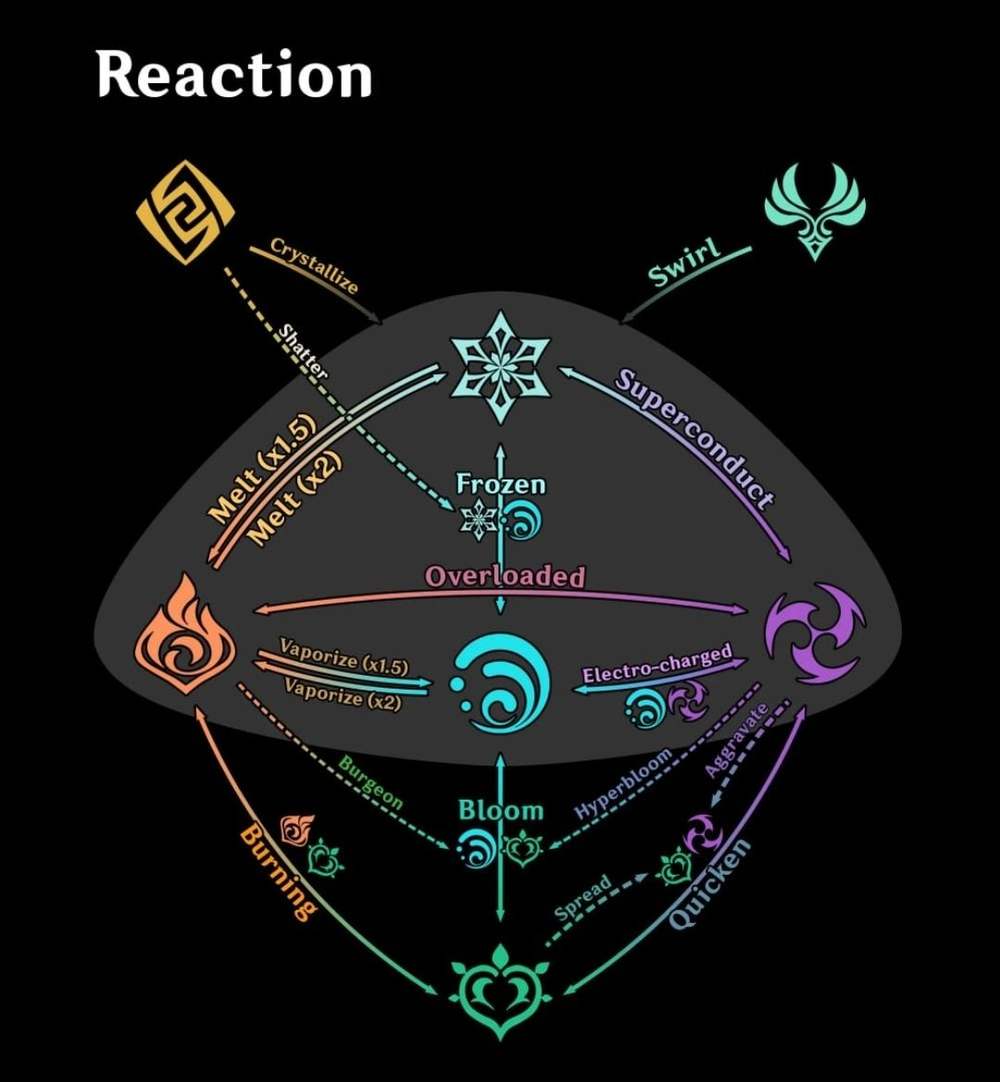ELEMENTAL REACTIONS IN GENSHIN IMPACT!
Elemental reactions are an essential gameplay mechanic in Genshin Impact. Understanding how different elements interact with each other can greatly enhance your combat effectiveness and make battles more manageable. In this article, we'll take a closer look at elemental reactions in Genshin Impact and how you can use them to your advantage.
Elements in Genshin Impact
There are seven elemental types in Genshin Impact: Pyro (fire), Hydro (water), Cryo (ice), Electro (lightning), Anemo (wind), Geo (earth), and Dendro (nature). Each element has unique characteristics and strengths, and they all interact with each other differently.
Elemental Reactions
Elemental reactions occur when two different elements come into contact with each other. Depending on the elements involved, the reaction can have different effects, such as dealing extra damage, applying debuffs, or creating environmental hazards. Below are the six elemental reactions currently available in Genshin Impact.
1. Overload (Pyro + Electro) - Causes a massive explosion and deals extra damage to enemies. The explosion also destroys nearby obstacles and can set enemies and objects on fire.
2. Superconduct (Cryo + Electro) - Reduces the physical resistance of enemies and deals bonus damage. Superconduct also applies the "Cryo" element to the target, which can be used to trigger other reactions.
3. Melt (Pyro + Cryo) - Deals bonus damage based on the target's current HP. Melt also applies a debuff that increases the target's susceptibility to the next reaction.
4. Vaporize (Hydro + Pyro) - Deals bonus damage and applies a debuff that increases the target's susceptibility to the next reaction. Vaporize can also turn water into steam, which can provide cover or obstruct enemy vision.
5. Freeze (Hydro + Cryo) - Immobilizes the target and applies the "Frozen" status, which can be used to trigger other reactions.
6. Swirl (Anemo + Pyro/Hydro/Cryo/Electro) - Causes an elemental infusion that deals bonus damage and spreads the element to nearby enemies. Swirl also applies the "Anemo" element to the target, which can be used to trigger other reactions.
7. Quicken (Electro + Dendro) – is triggered whenever Dendro meets Electro. This reaction can be applied in both ways, and it doesn't matter which element is applied first.
8. Aggravate (Quicken + Electro) - Once a target is quickened, you can apply Electro to it once again to trigger the Aggravate reaction. Once this reaction triggers, your next Electro attack will have increased damage based on the Elemental Mastery of the character.
9. Spread (Quicken + Dendro) - Similar to Aggravate, Spread can be triggered when you apply Dendro on a quickened enemy. This increases the Dendro damage dealt to that enemy.
10. Burning (Dendro + Pyro) - triggered each time you apply Pyro to an enemy who is also carrying Dendro. This is rather simple to detect because the enemy is covered in flames and is constantly taking Pyro damage.
11. Bloom (Dendro + Hydro) - When Hydro and Dendro come together, the bloom effect is activated, and a multifunctional Dendro seed is spawned on the ground next to the target.
12. Hyperbloom (Bloom + Electro) - When you apply electro to the seed, Hyperbloom triggered. The seed will then fly to one of the nearby enemies and cause Dendro damage.
13. Burgeon (Bloom + Pyro) - When Pyro is applied to the seed, Burgeon is triggered, and the seed explodes, doing greater damage over a wider area than it would have otherwise. It's crucial to remember that this will damaged your character as well.
Using Elemental Reactions
The key to effectively using elemental reactions in combat is to understand the strengths and weaknesses of each element and how they interact with each other. For example, Pyro and Electro are both highly offensive elements, while Cryo and Hydro are more defensive. To deal the most damage, try to trigger elemental reactions in quick succession and aim for enemy weaknesses.
It's also essential to consider your party composition when using elemental reactions. Different characters have different elemental affinities and can trigger reactions in different ways. For example, some characters have abilities that can apply multiple elements at once or enhance elemental damage. Experiment with different team compositions and find a playstyle that suits your preferences.
Conclusion
Elemental reactions are a critical gameplay mechanic in Genshin Impact, and understanding how they work can greatly enhance your combat effectiveness. Experiment with different elements and team compositions, trigger reactions in quick succession, and aim for enemy weaknesses to deal the most damage. With practice and experience, you'll become a master of elemental reactions in no time.














Komentar
Posting Komentar